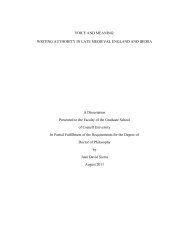CARPET WEAVERS AND WEAVING IN THE ... - Cornell University
CARPET WEAVERS AND WEAVING IN THE ... - Cornell University
CARPET WEAVERS AND WEAVING IN THE ... - Cornell University
You also want an ePaper? Increase the reach of your titles
YUMPU automatically turns print PDFs into web optimized ePapers that Google loves.
nothing but crocheting machines” (1982, 175). Unless craft development efforts work<br />
to change societal attitudes of relations to production, exploitation in craft production<br />
mirrors the biases of society in general (Milgram 2000, Scrase 2003, Nash 1993).<br />
In summary, it can be said that members of a community who are able to<br />
become part of the distribution network for craft products profit more from integration<br />
into the global economy than the artisans themselves. Wealthier members of a<br />
community and men in general are more likely to be able to take these roles, due to<br />
their social standing and access to education. Women are therefore likely to work in<br />
the less-profitable role of producer. Women’s work as artisans does not upset<br />
patriarchal structures when the craft is produced in the home. If men control the<br />
income generated by women then craft production is undervalued, seen as a duty<br />
amongst other duties women perform for the household. Craft production in the home<br />
can reinforce gender roles, but income generated through craft production may allow<br />
women to become more independent in cases where women are able to control this<br />
income.<br />
Issues raised in this area for the research include the following: Does weaving<br />
challenge or maintain the gender hierarchy in Turkey? What is the effect of control<br />
(or lack thereof) of income from weaving on women’s lives? Examination of these<br />
questions would touch on various aspects of the impact of income generation activities<br />
on the lives of women in rural Turkey.<br />
2.2.2 The effects of the tourist or export market<br />
Craft production in rural areas is often seasonal, following cycles of both crops and<br />
tourist presence (Milgram 2000, 114). This ebb and flow of work means that the<br />
situation of artisans is often not secure, and their work is generally undertaken as part<br />
10

















